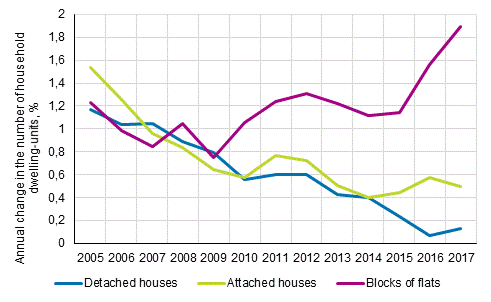Published: 17 May 2018
Living in blocks of flats grows in popularity
A comparison between house types reveals that household-dwelling units are piling into blocks of flats. According to Statistics Finland, the number of household-dwelling units living in blocks of flats grew from the previous year by 1.9 per cent or by 22,600 household-dwelling units. In total, 1,214,500 household-dwelling units were living in blocks of flats, nearly one-half of all household-dwelling units.
Annual change (%) in the number of household dwelling units by house type in 2005 to 2017

A household-dwelling unit is formed by persons living permanently in the same dwelling. In the light of annual changes in the numbers of household dwelling-units by house type, the year 2009 appears to be the turning point. In the subsequent years, the number of household-dwelling units has grown clearly faster in blocks of flats than in detached houses and terraced houses. In 2017, the number of household-dwelling units living in detached houses grew by just 0.1 per cent (1,400 household-dwelling units) and that of those living in terraced houses by half a per cent (1,800 household-dwelling units).
In total, the number of household-dwelling units grew by one per cent or by 25,400 household-dwelling units. Thus, the number of household-dwelling units was 2,680,000 at the end of 2017. The total change was slightly lower than the sum of house-type changes mentioned above, because the number of household-dwelling units living in other than residential buildings fell.
The growing number of household-dwelling units living in blocks of flats is partly explained by the increase in living alone, since, on average, three out of five of those living alone live in blocks of flats. In total, the number of one-person household-dwelling units was 1,162,300, that is, 43 per cent of all household-dwelling units.
Measured by the number of persons, the numbers of inhabitants are divided as follows: 1,941,100 persons were living in blocks of flats, 2,656,600 in detached houses and 711,700 in terraced houses. A total of 76,500 persons were living in other than residential buildings, such as commercial or office buildings.
Living in blocks of flats becomes more common among families with children
More and more families with children also find their home in a block of flats. The change is caused by living in blocks of flats becoming more common among families with children particularly in Greater Helsinki. In the rest of Finland, no corresponding development has taken place and a detached house is still by far the most popular choice among families with children. A household with children is a household including at least one child aged under 18.
In 2017, a total of 152,300 families with children, or 27 per cent of all, were living in block of flats. This is 0.9 per cent more than in 2016. The share of families with children living in blocks of flats was 57 per cent in Greater Helsinki, while the corresponding share was 19 per cent in the rest of Finland.
Housing of families with children by type of house: Greater Helsinki and rest of Finland in 2017

Tower buildings are rising at a steady rate
In recent years, the trend of construction has been to build high, impressive buildings. The trend is not restricted only to hotels and offices, but is also reflected in housing.
Twelve storeys can be considered one boundary of height, because buildings higher than that are often called tower blocks. According to the register, there were 59 tower blocks used for permanent housing in 2017. Tower blocks used for other than permanent housing, such as hotels or offices, are not included in the figure. The number of high residential blocks of flats has been growing steadily. For example, at the beginning of the 2010s, there were slightly over forty tower blocks used for housing.
Although the number of tower blocks has grown, a relatively small number of people are still living there. A total of 7,200 persons were living in houses with more than 12 storeys in 2017. People typically live alone or with one other person in a tower block, because just 7.5 per cent of household-dwelling units living in tower blocks included more than two persons.
Number of persons living in tower blocks in 2005 to 2017

Source: Dwellings and Housing Conditions, Statistics Finland
Inquiries: Otto Kannisto 029 551 3044, Marja Hermiö 029 551 3211, info@stat.fi
Director in charge: Jari Tarkoma
Publication in pdf-format (245.4 kB)
- Tables
-
Tables in databases
Pick the data you need into tables, view the data as graphs, or download the data for your use.
Appendix tables
Updated 17.5.2018
Official Statistics of Finland (OSF):
Dwellings and housing conditions [e-publication].
ISSN=1798-6761. 2017. Helsinki: Statistics Finland [referred: 19.4.2025].
Access method: http://stat.fi/til/asas/2017/asas_2017_2018-05-17_tie_001_en.html

